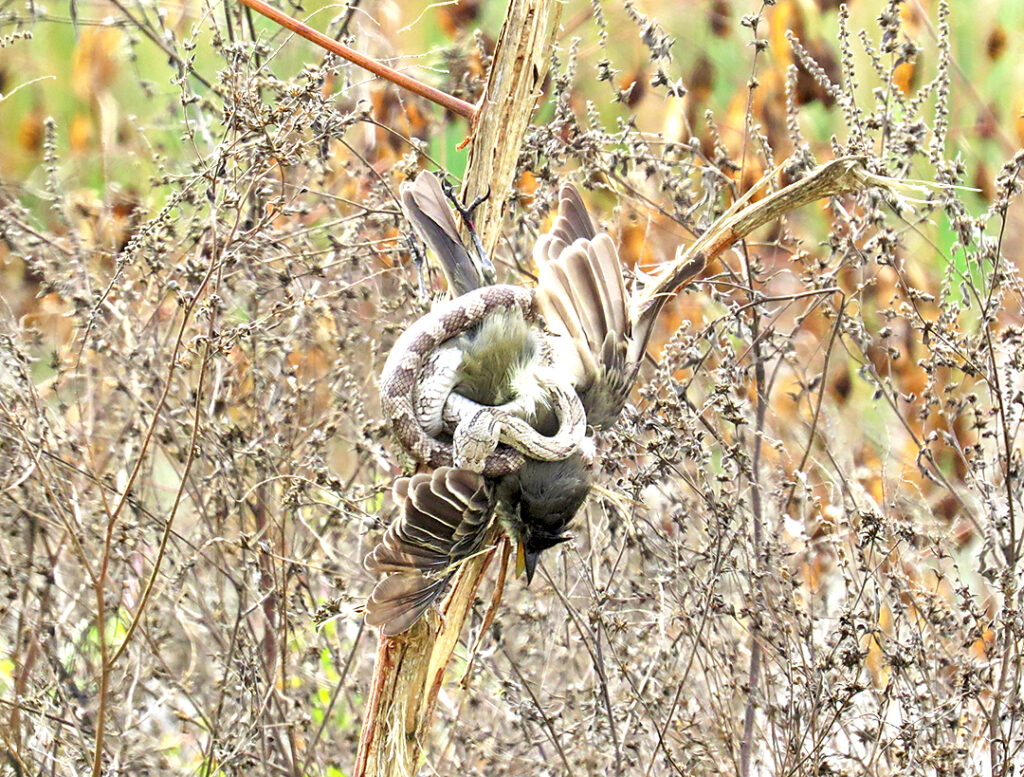Birding biathlon
By DON MORROW

A rat snake with a phoebe it killed.
A seriously oversubscribed schedule this month left me with a single day to do two bird surveys: a 6 a.m. duck survey to catch the morning Wood Duck flight, which would be followed at 1 p.m. by a shorebird survey to coincide with an afternoon high tide. A Birding Biathlon was about to begin. It was going to be a long day.
The refuge gate opened at 6 a.m. I picked up Barred Owl and Virginia Rail on my way out to Stony Bayou 2. It was a dark night with a thick low fog layer and no moon. A brisk cold wind was blowing out of the north
There never was a sunrise. The dark gray night slowly morphed into a pale gray morning. Soras began to call at 6:30 a.m. and two female Wood Ducks squealed. There was no morning flight.
Over the years, I have run this survey route almost 200 times and I have a sense of where birds should be. I scanned for stray ducks mixed in with coots or feeding along the edge of the cattails as I drove down the levee. I noticed that small birds were flying north, migrant warblers, probably yellow-rumps, that had overshot the coast in the fog.
When I do a survey, I concentrate on my target group, but I am a birder so I also watch what is around. Birds were flitting in the brush along the levee; Swamp and Savannah Sparrows, House Wrens, and Common Yellowthroats. Scanning the horizon, I saw a pair of eagles with their talons locked, cartwheeling through the sky.
Most of the ducks were on Mounds Pool 3 on both the North and South ends. Mostly Blue-winged Teal, but also Northern Pintail, Lesser Scaup, American Wigeon, Redhead, Green-winged Teal, Ruddy Duck, Gadwall, Canvasback, Mallard, Northern Shoveler, Ring-necked Duck, and a single Hooded Merganser. In total I had 589 ducks of fourteen species on the survey. This is a low duck number for November, but this does not always indicate a light winter season. Ducks are weather migrants and are often late if not pushed down by colder weather.
I finished the duck survey just after noon and swung around to rerun my route for the shorebird survey. As I drove down the Double Dikes trying to simultaneously unwrap a sandwich and not drive off the dike, I saw a flash of yellow. I hit the brakes, dropped the sandwich, and managed to get my binoculars on a Western Kingbird as it flew. The sun finally came out, but only for an hour.
Driving around the far end of Stony Bayou, I saw something on a bare branch. A small gray rat snake was wrapped around an Eastern Phoebe, a migrant that winters at the refuge. The phoebe had a yellowish wash on its belly, indicating a young first-year bird. It was already dead and the snake was trying to eat it. However, this was a small snake that had gotten lucky. It was thin and only about eighteen inches long. It was having trouble with the larger bird.
A bird’s annual migration cycle has always been a dangerous business. Weather events and predation during the round-trip flight or on the wintering grounds in unfamiliar territory take a significant toll. This phoebe may have been raised north of the rat snake’s range and may have had no prior experience with this predator.
To the natural sources of danger, we have added collisions with buildings and towers, feral cats, and pesticides. It is difficult to estimate total mortality, but in some years, it may approach fifty percent, most of which is human caused.
I found shorebirds on one of the old experimental ponds, on the salt flats and on the back edge of East River Pool, but over 70% of the shorebirds that I found on the refuge were concentrated on Tower Pond. In late morning on a low tide, I had two shorebirds there, an American Avocet and a Semipalmated Plover. Several hours later, at 3 p.m. on a high tide I had over 2,000 birds, mostly Dunlin.
Besides the Dunlin, there were hundreds of Willets, Western Sandpipers and Short-billed Dowitchers. There were smaller numbers of Greater Yellowlegs, Least Sandpipers, Semipalmated Plovers, Ruddy Turnstones, Marbled Godwits, Black-bellied Plovers, and avocets.
Checking other ponds and salt flats, I finished my shorebird survey by 4:30 p.m. and ended up with 2,879 shorebirds of fourteen species, which is right at the expected median number of shorebirds for a November survey. Sixty percent of the shorebirds were Dunlins.
My Birding Biathlon had taken ten and a half hours, starting in the dark and finishing late on a gloomy Fall afternoon. I logged 89 species for the day.
It was a good day of birding.
Don Morrow can be reached at donaldcmorrow@gmail.com.

